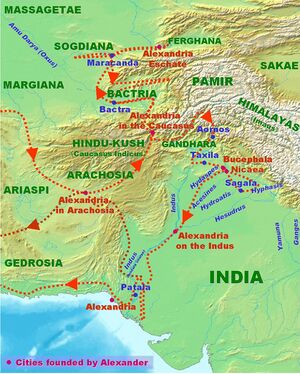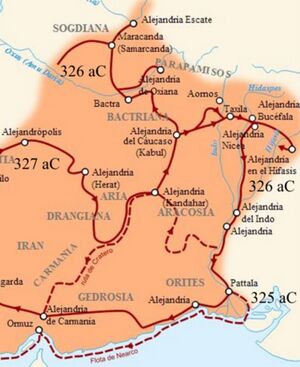Bucephalus
| Author:Laxman Burdak, IFS (R) |


Bucephalus (c. 355 BC – June 326 BC) was the horse of Alexander the Great, and one of the most famous actual horses of antiquity.[1] Ancient accounts[2] state that Bucephalus died after the Battle of the Hydaspes in 326 BC, in what is now modern Pakistan, and is buried in Jalalpur Sharif outside of Jhelum, Pakistan.
Variants of name
- Bucephala (Anabasis by Arrian, p. 296, 816.)
- Bucephalas (Anabasis by Arrian, p. 288, 296, 297.)
- Bucephala (बुकेफेला)
- Bucephalas
- Bucefela/Bukefela/Bukephela/Bucephela (बुकेफेला)(AS, p.640)
- Boukephala - the cities of Nikaia and Boukephala were renamed as Adirajya and Bhadrashva.[3]
Founded Bucephala town
Arrian[4] writes....Alexander founded two cities, one where the battle took place, and the other on the spot whence he started to cross the river Hydaspes; the former he named Nicaea,[5] after his victory over the Indians, and the latter Bucephala in memory of his horse Bucephalas.
Nicaea is supposed to be Mong and Bucephala may be Jelalpur. [5]
Location of Bucephala town
Bucephala, lay on the west bank of the Hydaspes river (modern-day Jhelum in Pakistan).[6] The modern-day town of Jalalpur Sharif, outside Jhelum, is said to be where Bucephalus is buried.[7]
Origin of name
It derives name from Greek bous, "ox" and kephalē, "head" meaning "ox-head".
Another account states that Bucephalus is buried in Phalia, a town in Pakistan's Mandi Bahauddin District, which is named after him.
Arrian states, with Onesicritus as his source, that Bucephalus died at the age of thirty. Other sources, however, give as the cause of death not old age or weariness, but fatal injuries at the Battle of the Hydaspes (June 326 BC), in which Alexander's army defeated King Porus. Alexander promptly founded a city, Bucephala, in honour of his horse. It lay on the west bank of the Hydaspes river (modern-day Jhelum in Pakistan).[8]
The modern-day town of Jalalpur Sharif, outside Jhelum, is said to be where Bucephalus is buried.[9]
Ch 5.19: Alliance with Porus.— death of Bucephalas
Arrian[10] writes.... When Alexander heard that Meroës was bringing Porus to him, he rode in front of the line with a few of the Companions to meet Porus; and stopping his horse, he admired his handsome figure and his stature,[1] which reached somewhat above five cubits. He was also surprised that he did not seem to be cowed in spirit,[2] but advanced to meet him as one brave man would meet another brave man, after having gallantly struggled in defence of his own kingdom against another king. Then indeed Alexander was the first to speak, bidding him say what treatment he would like to receive. The report goes that Porus replied: "Treat me, Alexander, in a kingly way!" Alexander being pleased at the expression, said: "For my own sake, Porus, thou shalt be thus treated; but for thy own sake do thou demand what is pleasing to thee!" But Porus said that everything was included in that, Alexander, being still more pleased at this remark, not only granted him the rule over his own Indians, but also added another country to that which he had before, of larger extent than the former.[3] Thus he treated the brave man in a kingly way, and from that time found him faithful in all things. Such was the result of Alexander's battle with Porus and the Indians living beyond the river Hydaspes, which was fought in the archonship of Hegemon at Athens, in the month Munychion[4] (18 April to 18 May, 326 B.C.).
Alexander founded two cities, one where the battle took place, and the other on the spot whence he started to cross the river Hydaspes; the former he named Nicaea,[5] after his victory over the Indians, and the latter Bucephala in memory of his horse Bucephalas, which died there, not from having been wounded by any one, but from the effects of toil and old age; for he was about thirty years old, and quite worn out with toil.[6] This Bucephalas had shared many hardships and incurred many dangers with Alexander during many years, being ridden by none but the king, because he rejected all other riders. He was both of unusual size and generous in mettle. The head of an ox had been engraved upon him as a distinguishing mark, and according to some this was the reason why he bore that name; but others say, that though he was black he had a white mark upon his head which bore a great resemblance to the head of an ox. In the land of the Uxians this horse vanished from Alexander, who thereupon sent a proclamation throughout the country that he would kill all the inhabitants, unless they brought the horse back to him. As a result of this proclamation it was immediately brought back. So great was Alexander's attachment to the horse, and so great was the fear of Alexander entertained by the barbarians.[7] Let so much honour be paid by me to this Bucephalas for the sake of his master.
1. Cf. Curtius, viii. 44; Justin, xii. 8.
2. Cf. Arrian, ii. 10 supra. δεουλωμένος τη γνωμη. The Scholiast on Thucydides iv. 34, explains this by τεταπεινωμένος φοβω.
3. Cf. Plutarch (Alex., 60); Curtius, viii. 51.
4. Diodorus (xvii. 87) says that the battle was fought in the archonship of Chremes at Athens.
5. Nicaea is supposed to be Mong and Bucephala may be Jelalpur. See Strabo, xv. 1.
6. Cf. Plutarch (Alex., 61). Schmieder says that Alexander could not have broken in the horse before he was sixteen years old. But since at this time he was in his twenty-ninth year he would have had him thirteen years. Consequently the horse must have been at least seventeen years old when he acquired him. Can any one believe this? Yet Plutarch also states that the horse was thirty years old at his death.
7. Curtius (vl. 17) says this occurred in the land of the Mardians; whereas Plutarch (Alex., 44) says it happened in Hyrcania.
बुकेफेला
विजयेन्द्र कुमार माथुर[11] ने लेख किया है ...बुकेफेला(AS, p.640): बुकेफेला नाम के नगर की स्थापना यवन राजा 'अलक्षेंद्र' (सिकन्दर) ने की थी। यह नगर 326 ई. पू. में झेलम नदी के किनारे बसाया गया था। बुकेफेला, अलक्षेंद्र के प्रिय घोड़े का नाम था और भारत के वीर राजा पुरु या पोरस के साथ युद्ध के पश्चात् इस घोड़े की मृत्यु इसी स्थान पर हुई थी। घोड़े की स्मृति में ही इस नगर का नाम बुकेफेला रखा गया था। इतिहासकार विंसेंट स्मिथ के अनुसार यह वर्तमान झेलम नाम के नगर (पाकिस्तान) के स्थान पर बसा हुआ था। बुकेफेला के चिन्ह नगर के पश्चिम की ओर एक विस्तृत टीले के रूप में आज भी देखे जा सकेते हैं। (दे. अर्ली हिस्ट्री ऑफ इंडिया,पृ.75)
References
- ↑ Aside from mythic Pegasus and the wooden Trojan Horse, or Incitatus, Caligula's favourite horse, proclaimed Roman consul.
- ↑ The primary (actually secondary) accounts are two: Plutarch's Life of Alexander, 6, and Arrian's Anabasis Alexandri V.19.
- ↑ Buddha Prakash: Evolution of Heroic Tradition in Ancient Panjab, X. The Struggle with the Yavanas, Sakas and Kushanas, p.101
- ↑ The Anabasis of Alexander/5b, Ch.19
- ↑ See Strabo, xv. 1.
- ↑ Rolf Winkes, "Boukephalas", Miscellanea Mediterranea (Archaeologia Transatlantica XVIII) Providence 2000, pp. 101–107.
- ↑ Michael Wood, "In the footsteps of Alexander the Great".
- ↑ Rolf Winkes, "Boukephalas", Miscellanea Mediterranea (Archaeologia Transatlantica XVIII) Providence 2000, pp. 101–107.
- ↑ Michael Wood, "In the footsteps of Alexander the Great".
- ↑ The Anabasis of Alexander/5b, Ch.19
- ↑ Aitihasik Sthanavali by Vijayendra Kumar Mathur, p.640

